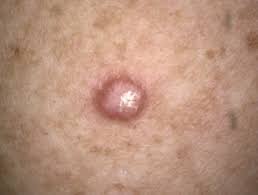Atypical Fibroxanthoma (AFX)
 AFX or atypical fibroxanthoma is a form of skin cancer which primarily takes place in older adults. Typically, tumor-like growths develop on those body areas that are sun exposed. Majority of these tumors are because of excessive sun exposure or therapeutic radiation treatments. Lesions in AFX can quickly develop over a few weeks or months. They have the potential to metastasize to other body parts.
AFX or atypical fibroxanthoma is a form of skin cancer which primarily takes place in older adults. Typically, tumor-like growths develop on those body areas that are sun exposed. Majority of these tumors are because of excessive sun exposure or therapeutic radiation treatments. Lesions in AFX can quickly develop over a few weeks or months. They have the potential to metastasize to other body parts.
Texas Surgical Dermatology, led by board certified dermatologist Dr. Tri H. Nguyen, provides treatments for AFX skin cancer to patients in Houston, Katy, Spring, The Woodlands, Texas, and surrounding locations.
Atypical Fibroxanthoma Symptoms
These are a few common characteristics of AFX:
- A small nodule appears on the cheeks, ears, nose, or back of the neck
- The tumor or nodule may grow to 2 to 3 cm in length in a few months
- The nodule may appear ulcerated or crusted
Diagnosing Atypical Fibroxanthomas
The clinical presentation of atypical fibroxanthoma is similar to other skin cancer forms. Pathologists can make definitive diagnosis through a skin biopsy after excising the area.
Treating Atypical Fibroxanthoma
Desiccation or curettage may be used for treating very small AFX nodules. Curette is used for scraping the affected area. It is then cauterized to prevent bleeding and destroy any remaining cancerous cells. For a long time, excision has been the primary treatment for this skin cancer.
Doctors generally remove a wide area of tissue since it can be difficult to define the tumor margins clearly. This is done to ensure that the margins are free of cancer cells. Excision, as a result, is best suited to situations that involve small tumors.
Treating AFX with Mohs Surgery
Mohs surgery is an advanced technique that is quickly becoming widely popular in case of recurrent or large tumors. A major advantage of Mohs surgery is that the surgeon removes a single layer of tissue each time. This layer is examined during the procedure using a microscope.
Mohs surgery allows the surgeon to remove just enough tissue for ensuring the margins become cancer-free. This removes the need for guesswork for determining the tumor depth. It also spares healthy tissue.
Long-term Prognosis of AFX
After wide local excision, AFX tumors have an estimated 8.7% recurrent rate. This is in comparison to 0% in case of Mohs surgery. Patients undergoing AFX treatment need to follow-up with their physicians for a minimum of 2 years for monitoring metastasis or possible recurrence.
Is Atypical Fibroxanthoma Aggressive?
Even though the tumors in AFX are unsightly, the skin cancer is usually benign. Unfortunately, the tumors are often misdiagnosed as other types of skin cancer since they are much less familiar and common. This can result in unnecessary radiation and extensive surgery.
Cure Rate for Atypical Fibroxanthoma (AFX)
The skin cancer rarely recurs once it is completely excised with clear margins. The cure rate is virtually 100%. Limiting sun exposure in the back of the neck and head is the key to preventing the development of additional growths.
Board certified dermatologist Dr. Tri H. Nguyen at Texas Surgical Dermatology receives patients from Houston, Katy, Spring, The Woodlands, Texas, and nearby areas for AFX skin cancer treatment.
For More Information contact our Board Certified in Dermatologists at Texas Surgical Dermatology in Spring, TX
For more information on procedures and treatments offered at Texas Surgical Dermatology PA please call 832.663.6566 or click here to contact our dermatologists. Helping patients in Houston, The Woodlands, Spring, Katy and other surrounding areas of Texas.

